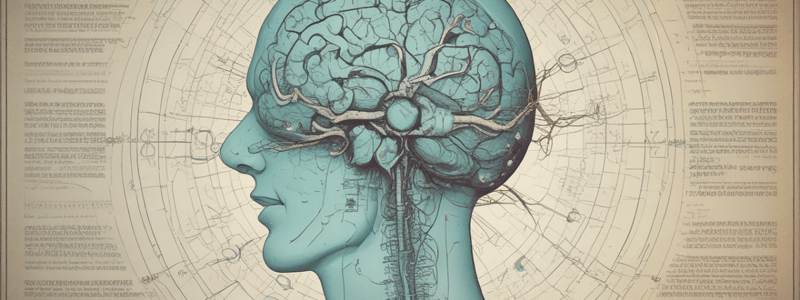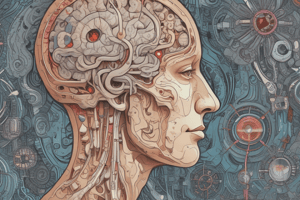Podcast
Questions and Answers
What is the term for the part of the brain that controls basic life functions, like breathing and heartbeat?
What is the term for the part of the brain that controls basic life functions, like breathing and heartbeat?
What is the name of the brain region involved in speech production?
What is the name of the brain region involved in speech production?
What is the term for the abnormal connection between arteries and veins in the brain?
What is the term for the abnormal connection between arteries and veins in the brain?
What is the fluid that surrounds the brain and spinal cord and provides cushioning and nutrients?
What is the fluid that surrounds the brain and spinal cord and provides cushioning and nutrients?
Signup and view all the answers
What is the term for the lack of muscle coordination, affecting balance and movement?
What is the term for the lack of muscle coordination, affecting balance and movement?
Signup and view all the answers
What is the term for the warning sign before a seizure, such as unusual smells or sensations?
What is the term for the warning sign before a seizure, such as unusual smells or sensations?
Signup and view all the answers
What is the term for the part of the nervous system that controls involuntary functions like heart rate and digestion?
What is the term for the part of the nervous system that controls involuntary functions like heart rate and digestion?
Signup and view all the answers
What is the term for the type of seizure involving brief, sudden lapses in attention and activity?
What is the term for the type of seizure involving brief, sudden lapses in attention and activity?
Signup and view all the answers
What is the term for the difficulty with language, affecting speaking, understanding, or both?
What is the term for the difficulty with language, affecting speaking, understanding, or both?
Signup and view all the answers
What is the term for the protective barrier that prevents certain substances in the blood from entering the brain?
What is the term for the protective barrier that prevents certain substances in the blood from entering the brain?
Signup and view all the answers
What is hemiparesis?
What is hemiparesis?
Signup and view all the answers
What is the term for a seizure that affects both sides of the brain from the start?
What is the term for a seizure that affects both sides of the brain from the start?
Signup and view all the answers
What is the function of the cerebrum?
What is the function of the cerebrum?
Signup and view all the answers
What is the term for a condition where blood flow to part of the brain is interrupted, causing brain damage?
What is the term for a condition where blood flow to part of the brain is interrupted, causing brain damage?
Signup and view all the answers
What is the term for a prolonged seizure or series of seizures without full recovery in between?
What is the term for a prolonged seizure or series of seizures without full recovery in between?
Signup and view all the answers
What is the term for the opposite side of the body or brain?
What is the term for the opposite side of the body or brain?
Signup and view all the answers
Which part of the brain is involved in hearing and memory?
Which part of the brain is involved in hearing and memory?
Signup and view all the answers
What is the term for difficulty swallowing?
What is the term for difficulty swallowing?
Signup and view all the answers
What is the term for a brain region controlling hormones and body temperature?
What is the term for a brain region controlling hormones and body temperature?
Signup and view all the answers
What is the function of the sympathetic nervous system?
What is the function of the sympathetic nervous system?
Signup and view all the answers
What is the term for cells in the nervous system that support and protect neurons?
What is the term for cells in the nervous system that support and protect neurons?
Signup and view all the answers
What is the term for a fold of dura mater that separates the two cerebral hemispheres?
What is the term for a fold of dura mater that separates the two cerebral hemispheres?
Signup and view all the answers
What is the term for a temporary disruption of blood flow to the brain?
What is the term for a temporary disruption of blood flow to the brain?
Signup and view all the answers
What is the term for a type of seizure with muscle stiffening and jerking movements?
What is the term for a type of seizure with muscle stiffening and jerking movements?
Signup and view all the answers
What is the term for seizures with no identifiable cause?
What is the term for seizures with no identifiable cause?
Signup and view all the answers
What is the term for the pressure inside the skull?
What is the term for the pressure inside the skull?
Signup and view all the answers
What is the term for the stiffening and jerking movements seen in certain seizures?
What is the term for the stiffening and jerking movements seen in certain seizures?
Signup and view all the answers
What is the brain structure that relays sensory information to the cerebral cortex?
What is the brain structure that relays sensory information to the cerebral cortex?
Signup and view all the answers
What is the term for a fold of dura mater separating the cerebrum from the cerebellum?
What is the term for a fold of dura mater separating the cerebrum from the cerebellum?
Signup and view all the answers
What is the brain region involved in understanding language?
What is the brain region involved in understanding language?
Signup and view all the answers
What is the main cause of an ischemic stroke?
What is the main cause of an ischemic stroke?
Signup and view all the answers
Which part of the brain is responsible for processing sensory information?
Which part of the brain is responsible for processing sensory information?
Signup and view all the answers
What is the function of the myelin sheath around nerve fibers?
What is the function of the myelin sheath around nerve fibers?
Signup and view all the answers
What is the term for the gaps in the myelin sheath where nerve impulses are boosted?
What is the term for the gaps in the myelin sheath where nerve impulses are boosted?
Signup and view all the answers
What is the function of the parasympathetic nervous system?
What is the function of the parasympathetic nervous system?
Signup and view all the answers
What is the term for the recovery period after a seizure?
What is the term for the recovery period after a seizure?
Signup and view all the answers
What is the term for seizures caused by a specific trigger, such as a head injury or fever?
What is the term for seizures caused by a specific trigger, such as a head injury or fever?
Signup and view all the answers
What is the term for the network of neurons in the brain stem involved in arousal and alertness?
What is the term for the network of neurons in the brain stem involved in arousal and alertness?
Signup and view all the answers
What is the term for the process by which nerve impulses jump from one node of Ranvier to the next?
What is the term for the process by which nerve impulses jump from one node of Ranvier to the next?
Signup and view all the answers
What is the term for the part of the nervous system that controls voluntary movements?
What is the term for the part of the nervous system that controls voluntary movements?
Signup and view all the answers
Study Notes
Seizures and Brain Function
- Absence seizure: a brief, sudden lapse in attention and activity, often mistaken for daydreaming
- Aura: a warning sign before a seizure, such as unusual smells or sensations
- Automatisms: repetitive, unconscious movements, like lip-smacking, often occurring during seizures
- Focal seizure: a seizure that starts in one area of the brain
- Generalized seizure: a seizure that affects both sides of the brain from the start
- Grand mal seizure: a type of generalized seizure with muscle stiffening (tonic) and jerking movements (clonic)
- Provoked seizure: a seizure caused by a specific trigger, such as a head injury or fever
- Unprovoked seizure: a seizure with no identifiable cause
Brain Structure and Function
- Basal ganglia: brain structures involved in movement control
- Brain stem: the part of the brain that controls basic life functions, like breathing and heartbeat
- Cerebellum: the part of the brain that controls balance and coordination
- Cerebral cortex: the outer layer of the brain involved in complex thinking, perception, and voluntary movement
- Cerebrum: the largest part of the brain, responsible for higher brain functions like thought and action
- Frontal lobe: the part of the brain involved in decision-making, problem-solving, and movement
- Occipital lobe: the part of the brain responsible for vision
- Parietal lobe: the part of the brain involved in processing sensory information
- Temporal lobe: the part of the brain involved in hearing and memory
Nerve Function and Neurotransmission
- Afferent nerve fibers: nerve fibers that carry sensory information from the body to the brain
- Efferent nerve fibers: nerve fibers that carry signals from the brain to the muscles
- Myelin: the protective sheath around nerve fibers that speeds up nerve impulses
- Nodes of Ranvier: gaps in the myelin sheath where nerve impulses are boosted
- Neurotransmitter: chemicals that transmit signals across a synapse between neurons
- Receptor: a protein on a cell that receives signals from neurotransmitters or hormones
- Saltatory conduction: the process by which nerve impulses jump from one node of Ranvier to the next
Other Neurological Concepts
- Arteriovenous malformation (AVM): an abnormal connection between arteries and veins in the brain, which can cause bleeding
- Ataxia: lack of muscle coordination, affecting balance and movement
- Aphasia: difficulty with language; expressive aphasia affects speaking, receptive aphasia affects understanding, and global aphasia affects both
- Autonomic nervous system (ANS): the part of the nervous system that controls involuntary functions like heart rate and digestion
- Blood-brain barrier: a protective barrier that prevents certain substances in the blood from entering the brain
- Cerebrospinal fluid (CSF): the fluid surrounding the brain and spinal cord that provides cushioning and nutrients
- Hemorrhagic stroke: a stroke caused by bleeding in the brain
- Ischemic stroke: a stroke caused by a blockage in a blood vessel supplying the brain
- TIA (transient ischemic attack): a temporary disruption of blood flow to the brain, often called a "mini-stroke"
Studying That Suits You
Use AI to generate personalized quizzes and flashcards to suit your learning preferences.
Related Documents
Description
A quiz on various medical terms related to the brain and nervous system, including seizures, nerve fibers, language disorders, and blood vessel abnormalities.



